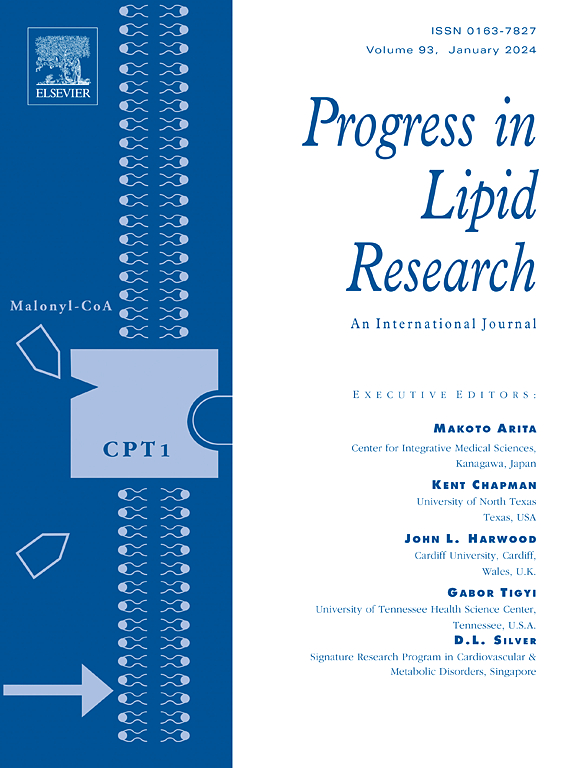EPA和DHA在人体内的生物利用度综述。
IF 14
1区 医学
Q1 BIOCHEMISTRY & MOLECULAR BIOLOGY
引用次数: 0
摘要
长链omega-3脂肪酸的生物利用度是影响其功效的一个关键因素,但往往被忽视。本综述评估了急性(单剂量)和慢性人体研究中EPA/DHA的生物利用度,重点是(a)化学形式,如三酰甘油(TAG,天然和再酯化,rTAG),游离脂肪酸(FFA)和磷脂(PL),如鱼,磷虾和微藻,以及(b)微胶囊化和乳化等递送方法。分离化学形式的生物利用度顺序为:FFA > PL > rTAG >未修饰TAG >乙酯(EE)。然而,不同的油成分使来源特异性生物利用度的结论复杂化。在急性生物利用度研究中观察到的显著差异(例如,更快的吸收)通常不会转化为慢性补充研究中的长期影响。这就提出了关于急性发现的临床相关性的问题,特别是考虑到n-3 PUFA补充剂通常是长期服用的。方法学上的局限性,如不合适的生物标志物、较短的采样窗口和不充分的产品表征,阻碍了研究的可靠性和可比性。这篇综述强调需要标准化的方案和强有力的慢性研究来阐明生物利用度差异的临床意义。未来的研究应优先考虑反映持续n-3 PUFA状态的生物标志物,以更好地了解各种EPA和DHA配方的健康益处。本文章由计算机程序翻译,如有差异,请以英文原文为准。
Bioavailability of EPA and DHA in humans – A comprehensive review
The bioavailability of long-chain omega-3 fatty acids is a critical yet often overlooked factor influencing their efficacy. This review evaluates the bioavailability of EPA/DHA from acute (single-dose) and chronic human studies, focusing on (a) chemical forms such as triacylglycerols (TAG, natural and re-esterified, rTAG), non-esterified fatty acids (NEFA), and phospholipids (PL) from sources like fish, krill, and microalgae, and (b) delivery methods like microencapsulation and emulsification. Bioavailability for isolated chemically forms followed the order: NEFA > PL > rTAG > unmodified TAG > ethyl esters (EE). However, varying oil compositions complicate conclusions about source-specific bioavailability. Significant differences observed in acute bioavailability studies (e.g., faster absorption) often did not translate into long-term impacts in chronic supplementation studies. This raises questions about the clinical relevance of acute findings, especially given that n-3 PUFA supplements are typically consumed long-term. Methodological limitations, such as inappropriate biomarkers, short sampling windows, and inadequate product characterization, hinder the reliability and comparability of studies. The review emphasizes the need for standardized protocols and robust chronic studies to clarify the clinical implications of bioavailability differences. Future research should prioritize biomarkers that reflect sustained n-3 PUFA status to better understand the health benefits of various EPA and DHA formulations.
求助全文
通过发布文献求助,成功后即可免费获取论文全文。
去求助
来源期刊

Progress in lipid research
生物-生化与分子生物学
CiteScore
24.50
自引率
2.20%
发文量
37
审稿时长
14.6 weeks
期刊介绍:
The significance of lipids as a fundamental category of biological compounds has been widely acknowledged. The utilization of our understanding in the fields of biochemistry, chemistry, and physiology of lipids has continued to grow in biotechnology, the fats and oils industry, and medicine. Moreover, new aspects such as lipid biophysics, particularly related to membranes and lipoproteins, as well as basic research and applications of liposomes, have emerged. To keep up with these advancements, there is a need for a journal that can evaluate recent progress in specific areas and provide a historical perspective on current research. Progress in Lipid Research serves this purpose.
 求助内容:
求助内容: 应助结果提醒方式:
应助结果提醒方式:


